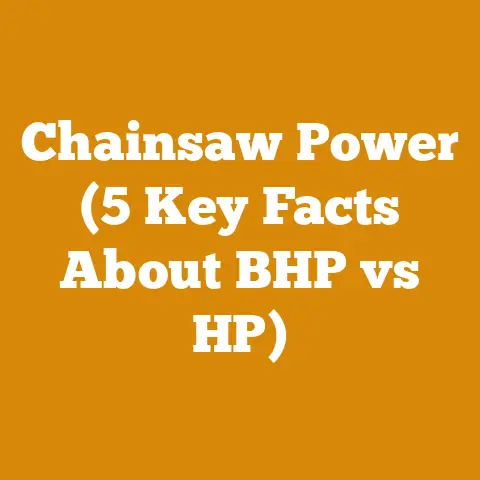Stihl MS250 Used Price Guide (5 Pro Tips for Woodcutters)
Stihl MS250 Used Price Guide (5 Pro Tips for Woodcutters)
The Problem: Finding the Right Used Chainsaw at the Right Price
Have you ever stared at a pile of firewood to split, or a downed tree blocking your driveway, and thought, “I need a chainsaw!” But then, the price tag on a new one makes you wince? You’re not alone. Many woodcutters, from weekend warriors to seasoned pros, are looking for a reliable, affordable option. That’s where the used market comes in, and the Stihl MS250 is a popular choice. However, navigating the used chainsaw market is like walking through a forest – you need a map, a compass, and a keen eye to avoid getting lost or taken advantage of. Many people, especially beginners, struggle to determine a fair price for a used Stihl MS250 and lack the knowledge to assess its condition properly. Overpaying for a lemon is a woodcutter’s worst nightmare.
This guide is your map and compass. I’m going to walk you through everything you need to know to confidently purchase a used Stihl MS250, ensuring you get a reliable tool at a fair price. We’ll delve into the factors that influence its value, how to inspect a used saw, and provide pro tips to help you secure the best deal possible. This isn’t just about saving money; it’s about investing wisely in a tool that will serve you well for years to come.
Why the Stihl MS250?
Before we dive into pricing, let’s understand why the Stihl MS250 is such a sought-after model. From my own experience, and talking with countless other woodcutters, its popularity stems from its:
- Versatility: It’s powerful enough for felling small to medium-sized trees yet lightweight enough for limbing and pruning.
- Reliability: Stihl has a reputation for building robust, long-lasting tools, and the MS250 is no exception.
- Ease of Use: It’s relatively simple to operate and maintain, making it a good choice for both beginners and experienced users.
- Parts Availability: Because it’s a popular model, parts are readily available and relatively inexpensive, both new and aftermarket.
These factors contribute to its enduring value on the used market.
Factors Influencing the Used Price of a Stihl MS250
Determining the fair price of a used Stihl MS250 is not as simple as checking a blue book. Several factors come into play, and understanding them is crucial for making an informed decision.
1. Condition:
This is the single most important factor. A saw in excellent condition will command a higher price than one that’s been heavily used and abused.
- Excellent Condition: A saw that appears almost new, with minimal signs of wear and tear. It starts easily, runs smoothly, and has been well-maintained. Expect to pay a premium.
- Good Condition: A saw that shows some signs of use but is still in good working order. It may have some scratches or minor cosmetic imperfections, but it starts reliably and runs well.
- Fair Condition: A saw that shows significant signs of use. It may have some mechanical issues, such as a worn chain or a slightly rough idle. It may require some maintenance or repairs.
- Poor Condition: A saw that is in need of significant repairs. It may be difficult to start, run poorly, or have major mechanical problems. Avoid these unless you’re a skilled mechanic and looking for a project.
Data Point: In my experience, a Stihl MS250 in “Excellent” condition can fetch 60-80% of its original new price, while one in “Fair” condition might only be worth 30-40%.
2. Age:
The age of the saw also plays a role, although not as significant as condition. A newer saw will generally be worth more than an older one, assuming they are in similar condition.
Data Point: While Stihl doesn’t release precise production dates that are easily publicly accessible, you can often infer the approximate age based on features or serial numbers (consulting with a Stihl dealer or online forums can help). Generally, saws over 10 years old will be priced lower, even if they are in good condition.
3. Location:
Location can influence the price due to regional demand and availability. In areas where firewood is a primary heating source, or where logging is a common occupation, the demand for chainsaws will be higher, potentially driving up prices.
Data Point: I’ve observed that prices for used chainsaws tend to be higher in rural areas with a strong logging or firewood-burning culture compared to urban areas.
4. Seller Reputation:
Buying from a reputable seller, such as a Stihl dealer or a well-established online vendor, can provide some assurance of quality and potentially offer a warranty or return policy. Private sellers can offer better deals, but you’ll need to do your due diligence to assess the saw’s condition.
5. Included Accessories:
A used Stihl MS250 that comes with extra chains, a carrying case, or other accessories will be worth more than one that is sold bare.
Estimating the Fair Price: A Data-Driven Approach
While a precise price is impossible to determine without inspecting the specific saw, we can use available data and benchmarks to estimate a reasonable range.
1. New Price as a Baseline:
First, determine the current new price of a Stihl MS250 in your area. You can find this information on the Stihl website or by contacting a local Stihl dealer.
Data Point: As of late 2024, a new Stihl MS250 typically retails for around $400 – $450 USD (prices may vary based on location and promotions).
2. Depreciation Calculation:
Next, factor in depreciation based on age and condition. A general guideline is to deduct 10-20% per year for the first few years, then a smaller percentage as the saw ages. Condition is paramount, as a well-maintained older saw can be worth more than a poorly maintained newer one.
Example:
- Let’s assume a 5-year-old Stihl MS250 in good condition.
- New price: $425
- Depreciation: 15% per year for the first 3 years (45%), then 10% for the next 2 years (20%). Total depreciation: 65%.
- Estimated value: $425 – (65% of $425) = $148.75
3. Condition Adjustment:
Adjust the estimated value based on the specific condition of the saw.
- Excellent: Add 20-30% to the estimated value.
- Good: No adjustment needed.
- Fair: Subtract 10-20% from the estimated value.
- Poor: Subtract 30-50% from the estimated value (or avoid altogether).
Example (Continuing from above):
- The saw is in “Good” condition, so no adjustment is needed.
- Estimated fair price: $148.75
4. Market Research:
Check online marketplaces like eBay, Craigslist, and Facebook Marketplace for similar used Stihl MS250s in your area. This will give you a sense of what other people are asking for and what prices are actually being paid.
Data Point: Regularly monitoring these platforms provides valuable real-time data on market trends and pricing fluctuations.
5. Consider Local Factors:
Adjust your estimate based on local demand and availability. If there are few used Stihl MS250s available in your area, you may need to pay a premium.
Important Note: These are just estimates. Always inspect the saw thoroughly before making an offer.
5 Pro Tips for Woodcutters Buying a Used Stihl MS250
Now, let’s get to the heart of the matter: how to ensure you’re getting a good deal and a reliable saw. These are the tips I’ve learned over the years, often the hard way.
Pro Tip #1: The Pre-Purchase Inspection – Your Best Defense
This is the most crucial step. Don’t buy a used chainsaw without thoroughly inspecting it first. If the seller won’t let you inspect it, walk away.
Here’s a checklist of what to look for:
- Visual Inspection:
- Overall Condition: Check for signs of excessive wear, damage, or neglect. Look for cracks in the housing, loose screws, or missing parts.
- Bar and Chain: Inspect the bar for wear and damage, such as bent rails or excessive wear grooves. Check the chain for sharpness, damage, and proper tension. The chain should fit snugly on the bar without being too tight or too loose.
- Air Filter: Remove the air filter and inspect it for dirt and debris. A dirty air filter can restrict airflow and damage the engine.
- Spark Plug: Remove the spark plug and inspect it for fouling or damage. A fouled spark plug can indicate engine problems.
- Fuel and Oil Tanks: Check the fuel and oil tanks for leaks or cracks. Ensure the caps are secure and the fuel lines are in good condition.
- Mechanical Inspection:
- Compression Test: This is critical. Pull the starter cord slowly. You should feel strong resistance. A lack of compression indicates a worn engine. You can also use a compression tester (if you have one) to get a more accurate reading. A reading below 100 PSI is a red flag.
- Starting: Try to start the saw. It should start easily, usually within a few pulls. Difficulty starting can indicate problems with the carburetor, ignition system, or fuel lines.
- Idle: Once started, the saw should idle smoothly without stalling or racing. An erratic idle can indicate carburetor problems.
- Acceleration: Rev the engine. It should accelerate smoothly and quickly without hesitation or bogging down. Hesitation or bogging can indicate carburetor problems or a dirty air filter.
- Chain Brake: Test the chain brake. It should engage quickly and stop the chain immediately. A faulty chain brake is a safety hazard.
- Oiling System: Run the saw for a few seconds and check to see if the chain is being properly lubricated. A lack of lubrication can cause the bar and chain to overheat and wear prematurely.
- Smell Test:
- Fuel Smell: A strong gasoline smell can indicate a fuel leak.
- Burning Smell: A burning smell can indicate engine overheating or a lack of lubrication.
Pro Tip #2: Listen to Your Gut (and the Engine)
Pay attention to the sounds the saw makes. A healthy engine will sound smooth and consistent. Unusual noises, such as knocking, rattling, or hissing, can indicate problems.
Personal Story: I once bought a used chainsaw that sounded “okay” at first. But after a few minutes of running, I noticed a faint rattling sound. I ignored it, thinking it was minor. Big mistake! A few weeks later, the engine seized. Turns out, the connecting rod was damaged. I learned my lesson: trust your ears!
Pro Tip #3: Negotiate with Confidence
Don’t be afraid to negotiate the price. Point out any flaws you find during your inspection. Be polite but firm. Remember, the seller is trying to get the best price possible, and you’re trying to get the best deal.
Negotiation Tactics:
- Do Your Research: Know the fair market value of the saw before you start negotiating.
- Be Prepared to Walk Away: If the seller is unwilling to negotiate or if you’re not comfortable with the price, be prepared to walk away. There are plenty of other used chainsaws out there.
- Focus on Flaws: Point out any flaws you find during your inspection and use them as leverage to lower the price.
- Offer a Lower Price: Start by offering a lower price than you’re willing to pay. This gives you room to negotiate.
- Be Respectful: Be polite and respectful throughout the negotiation process.
Pro Tip #4: Check for Stolen Goods
This is a serious issue. Before you buy a used chainsaw, check the serial number to make sure it hasn’t been reported stolen. You can contact your local police department or check online databases of stolen goods.
Why this matters: Buying stolen property is illegal, and you could lose the saw and face legal consequences.
Pro Tip #5: Factor in Repair Costs
Even if the saw appears to be in good condition, it’s wise to factor in potential repair costs. Used chainsaws are often sold “as is,” meaning you’re responsible for any repairs that are needed.
Budgeting for Repairs:
- Estimate Potential Costs: Research the cost of common repairs for the Stihl MS250, such as replacing the carburetor, spark plug, or air filter.
- Set Aside a Repair Fund: Set aside a small amount of money to cover potential repair costs.
- Consider a Tune-Up: Even if the saw seems to be running well, consider having it tuned up by a qualified mechanic. This can help prevent future problems and extend the life of the saw.
Understanding the Costs of Wood Processing and Firewood Preparation
Buying a used Stihl MS250 is just one piece of the puzzle. To truly budget effectively, you need to understand the overall costs of wood processing and firewood preparation. Let’s break it down:
1. Timber Acquisition Costs:
- Standing Timber: If you’re harvesting your own timber, you’ll need to factor in the cost of the timber itself. This can vary widely depending on the species, size, and quality of the trees.
- Data Point: According to the USDA Forest Service, the average stumpage price (the price paid for standing timber) in the US varies from a few dollars per thousand board feet (MBF) for low-quality hardwood to hundreds of dollars per MBF for high-quality softwood.
- Purchased Logs: If you’re buying logs, the price will depend on the species, size, and grade of the logs.
- Data Point: The average price per cord of mixed hardwood logs ranges from $80 to $150, depending on location and availability.
- Permits and Fees: Depending on your location, you may need to obtain permits or pay fees for harvesting timber.
2. Tool Costs:
- Chainsaw (Used Stihl MS250): As we’ve discussed, the price of a used Stihl MS250 can range from $100 to $300, depending on condition.
- Chainsaw Maintenance: Factor in the cost of chainsaw maintenance, including chain sharpening, bar oil, fuel, and repairs.
- Data Point: Chain sharpening can cost $5-$10 per chain, or you can invest in a chain sharpening tool for around $50-$100.
- Rule of Thumb: I typically budget about $50-$100 per year for chainsaw maintenance.
- Splitting Tools: If you’re splitting firewood, you’ll need a splitting axe or a hydraulic log splitter.
- Data Point: A good quality splitting axe can cost $50-$100, while a hydraulic log splitter can cost several hundred to several thousand dollars, depending on size and power.
- Safety Gear: Don’t skimp on safety gear. You’ll need a helmet, eye protection, hearing protection, gloves, and chaps.
- Data Point: A basic set of safety gear can cost $100-$200.
3. Labor Costs:
- Your Time: If you’re doing the work yourself, factor in the value of your time. How much is your time worth per hour?
- Hired Labor: If you’re hiring someone to help you, factor in their wages.
- Data Point: The average hourly wage for a logger or firewood handler ranges from $15 to $25, depending on experience and location.
4. Transportation Costs:
- Fuel: Factor in the cost of fuel for transporting logs or firewood.
- Vehicle Maintenance: Factor in the cost of vehicle maintenance, such as oil changes and tire replacements.
5. Drying Costs:
- Time: Firewood needs to be properly dried before it can be burned. This can take several months, depending on the species of wood and the climate.
- Storage: You’ll need a place to store the firewood while it’s drying. This could be a shed, a tarp, or simply a stack in your yard.
Calculations and Formulas:
- Estimating Cord Volume: A cord of wood is a stack that measures 4 feet high, 4 feet wide, and 8 feet long, totaling 128 cubic feet. However, the actual amount of solid wood in a cord varies depending on the size and shape of the logs.
- Estimating Drying Time: The drying time for firewood depends on several factors, including the species of wood, the size of the pieces, the climate, and the stacking method. As a general rule, hardwood firewood needs to dry for at least six months, while softwood firewood can dry in as little as three months.
Cost Optimization Tips:
- Buy in Bulk: Buying logs or timber in bulk can often save you money.
- Season Your Own Firewood: Seasoning your own firewood can save you money compared to buying pre-seasoned firewood.
- Maintain Your Equipment: Regularly maintaining your equipment can help prevent costly repairs.
- Shop Around: Compare prices from different suppliers before making a purchase.
- Do it Yourself: If you’re able to do the work yourself, you can save on labor costs.
Case Studies: Real-World Examples
Let’s look at a couple of hypothetical case studies to illustrate how these cost factors come into play.
Case Study 1: The Weekend Warrior
John is a homeowner who wants to cut and split his own firewood for his fireplace. He buys a used Stihl MS250 for $200. He already has a splitting axe and some basic safety gear. He buys a cord of mixed hardwood logs for $100. He spends 20 hours cutting and splitting the wood. He values his time at $20 per hour.
- Timber Costs: $100
- Tool Costs: $200 (used chainsaw) + $50 (maintenance) = $250
- Labor Costs: 20 hours x $20/hour = $400
- Transportation Costs: $50
- Total Cost: $800
- Cost per Cord: $800
Case Study 2: The Small-Scale Firewood Supplier
Maria is a small-scale firewood supplier who sells firewood to local customers. She buys standing timber for $50 per MBF. She hires a logging crew to fell and buck the trees. She buys a used Stihl MS250 for $250. She owns a hydraulic log splitter.
- Timber Costs: $50/MBF
- Logging Costs: $100/MBF
- Tool Costs: $250 (used chainsaw) + $100 (maintenance) = $350
- Labor Costs: $20/hour for splitting and stacking
- Transportation Costs: $100
- Total Cost: Varies depending on volume
- Cost per Cord: Calculated based on total volume and costs
These case studies highlight the importance of carefully considering all cost factors when budgeting for wood processing and firewood preparation.
Global Perspective: Wood Prices and Firewood Markets
The cost of wood and firewood varies significantly around the world, depending on factors such as:
- Forest Resources: Countries with abundant forest resources tend to have lower wood prices.
- Labor Costs: Countries with lower labor costs tend to have lower firewood prices.
- Transportation Costs: Transportation costs can significantly impact the price of wood and firewood, especially in remote areas.
- Government Regulations: Government regulations, such as logging restrictions and carbon taxes, can also affect wood prices.
Data Points:
- In Scandinavia, where forests are abundant, firewood prices tend to be lower than in many other parts of Europe.
- In developing countries, where labor costs are low, firewood is often a more affordable heating option than fossil fuels.
- In some countries, governments offer subsidies or tax breaks to encourage the use of renewable energy sources, such as firewood.
Understanding these global trends can provide valuable context for your own budgeting and cost management efforts.
Actionable Takeaways and Next Steps
Buying a used Stihl MS250 can be a smart way to save money and get a reliable tool for your wood processing or firewood preparation projects. But it’s essential to do your research, inspect the saw thoroughly, and negotiate with confidence.
Here are some actionable takeaways:
- Research: Understand the fair market value of a used Stihl MS250 in your area.
- Inspect: Thoroughly inspect any saw before you buy it, paying attention to its condition, age, and included accessories.
- Negotiate: Don’t be afraid to negotiate the price.
- Safety: Always wear appropriate safety gear when operating a chainsaw.
- Budget: Carefully budget for all costs associated with wood processing and firewood preparation, including timber, tools, labor, transportation, and drying.
Next Steps:
- Start Your Search: Begin your search for a used Stihl MS250 on online marketplaces or at local Stihl dealers.
- Schedule Inspections: Schedule inspections with sellers who have saws that meet your criteria.
- Prepare to Negotiate: Be prepared to negotiate the price based on your inspection.
- Stay Safe: Prioritize safety when operating your chainsaw.
- Enjoy the Process: Wood processing and firewood preparation can be rewarding activities. Enjoy the process!
By following these tips, you can confidently purchase a used Stihl MS250 and successfully manage your wood processing or firewood preparation projects. Remember, knowledge is power, and a well-informed woodcutter is a successful woodcutter. Now get out there and start cutting!






